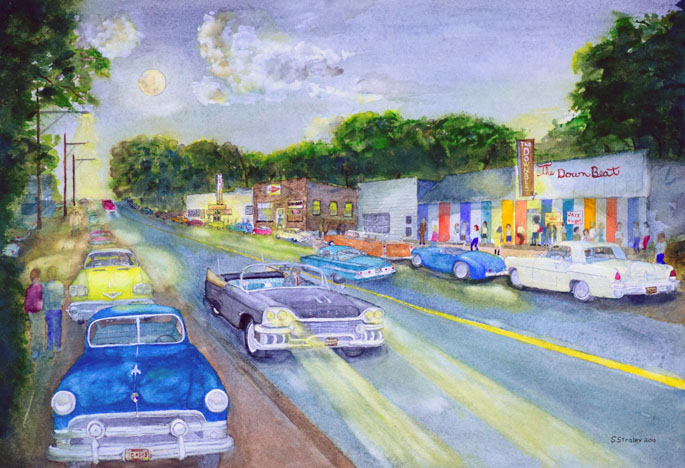Downbeat Club
Sunset Drive
Spring Park
Much of the information for this page comes from the October 2021 Newsletter of the Westonka Historical Society, written by Elizabeth Vandam.
THE HOLLOW
Only a short stretch long, the Hollow, as the locals still call it, was a section of Sunset Drive along the shore of West Arm on Lake Minnetonka in Spring Park. Incredibly, there were two hugely popular jazz venues on each side of this small stretch of road from about the 1940s to about 1970: The Downbeat was on the north side, and the Lakeview was on the south. Patrons came from all over the area (at the time a 25 minute drive from Downtown Minneapolis) to hear some of the biggest and best purveyors of jazz in the world. Some even came by boat!
THE DOWNBEAT
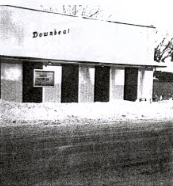
Jack Mellon owned the bar in 1954.
Dick and Jenny Bruzek bought it in 1954 and it flourished from then until the late 1960s.
Stan Haugesag played trombone there in August 1956.
In July 1957, Percy Hughes was in residence.
On June 9, 1959, Will Jones reported that the big news in Spring Park was “the driving two-trombone work of George Myers and Byron Snow.” The club’s quartet had been working on using the two-trombone sound since the previous September, using the arrangements of Kai Winding. Winding himself had been by to listen and approve.
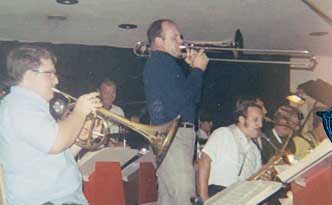
In 1960, the house band featured four trombones, as did Winding’s septet. Winding performed at the Club on May 25 and 26, 1960.
FAN MAIL FROM SOME JUNIOR
The Downbeat was catching on with the college crowd. An article in the Minnesota Daily appeared by Paul Boike, identified as a jazz critic and a junior. Since he had graduated from high school in 1958, the undated review would probable date to 1959 or 1960. For some reason Boike deemed the Lakeview a “disaster area,” but
For the rest of you who have some accurate idea of what the world is all about, let me recommend the Downbeat Club and urge my recommendation upon you in the strongest terms. If you like jazz a lot or just somewhat, the Downbeat is the biggest ball presently available in this area. And only on Sunday.
The reason for this is a big, muscular, swinging band under the direction of George Myers. One night of listening to a band like this sets you up for the whole week. It’s that good. Myers’ band is a full jazz orchestra capable of frenetic, up-tempo screamers and beautiful, consummately danceable ballad jazz. It is a band composed of the premier jazz talent of the Twin Cities, the very best men in the area all in a bundle.
… Myers has tenor-men Bob Crea and Ed Boike, altoist Don Rustad, trumpeter Jack Coan and trombonist Byron Snow, all excellent soloists. Individually and collectively, these men blow the kind of music that has been so long absent from this area as to be almost forgotten. Yet the experiences of hearing them is not one of recollection. It’s something fresh, a first-time thing.
On May 20, 1962, trombonist and bandleader Si Zentner came to the Downbeat. Ad below courtesy Robb Henry.
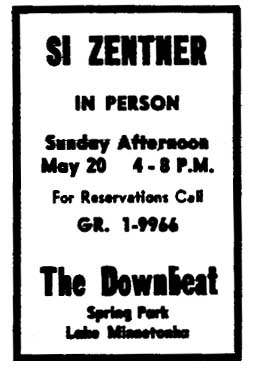
Winding returned on Sunday through Tuesday, October 14 to 16, 1962. The Sunday show ended at 8 pm, and the George Myers septet with singer Dickie Mayes took over until midnight.
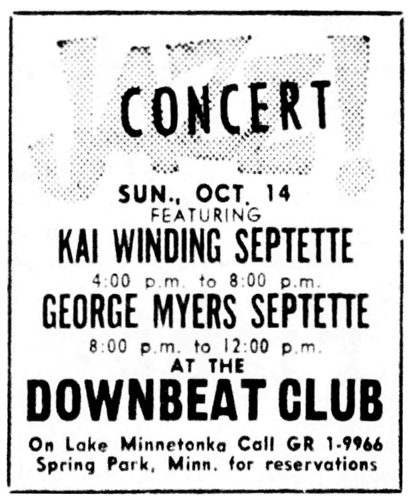
On May 9, 1963, Woody Herman and His Big Band made a one night stand at the Downbeat.
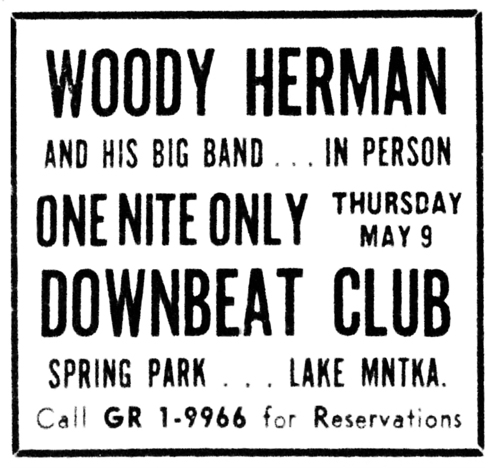
Woody Herman returned on October 22 and 24, 1963.
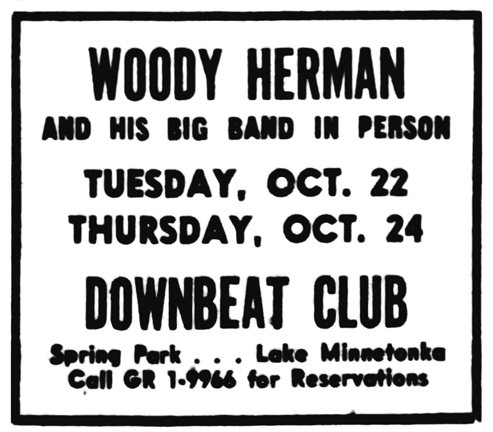
On March 17, 1964, Bob Murphy reported that the club resumed live entertainment for the season, with Dickie Mayes and his 13-piece band performing. Mayes would play Sundays from 5 to 9, and the George Myers Septet had the Saturday spot from 9 to 12:30.
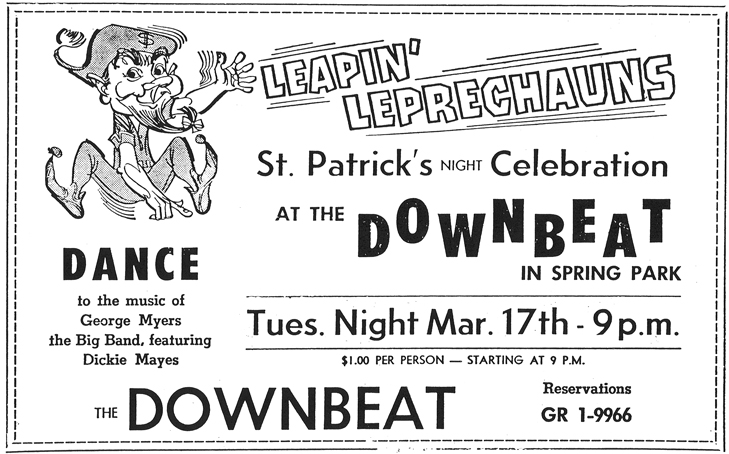
Apparently jazz was not the only thing on the music menu, as the ad below from the Minnesota Daily indicates. There is no date other than the year 1964.
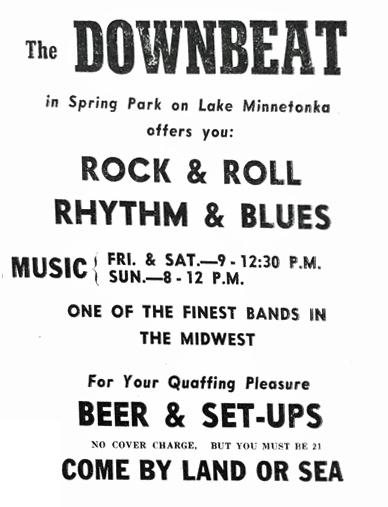
Si Zentner was yet another trombonist with a Big Band. He performed at the Downbeat on June 26 to 28, 1964.
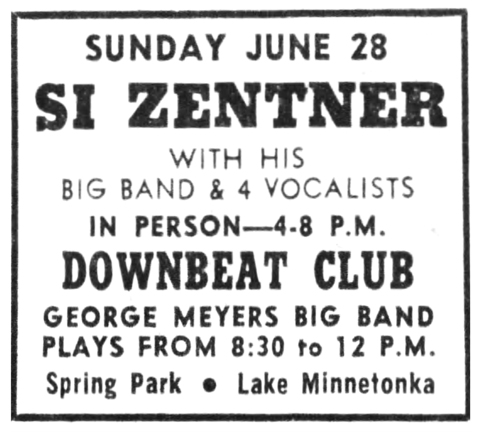
Jimmy Dorsey’s Band came through on August 14 to 16, 1964, featuring Lee Castle.
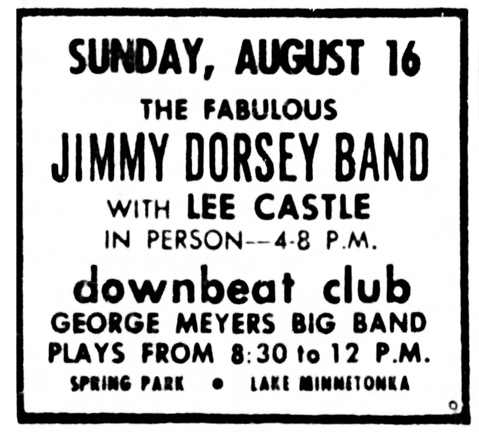
Will Jones reported on June 2, 1965, that Leigh Kamman had begun tape recording the George Myers Big Band and broadcasting the tapes on KQRS and KQRS-FM on Friday and Saturday nights from 10:30 to 11:00 pm.
Will Jones dedicated his entertainment column in the Tribune to the clubs in Spring Park on June 13, 1967, perhaps the last time they were mentioned. He noted that in George Myers band one could find Jack Coan, who was also one of the heralds who blew the silver trumpets that summon Guthrie theatergoers to their seats. Another was Dave Karr, who played saxophone and flute while following the actors around in the Guthrie play “The Thieves’ Carnival.” And the great Percy Hughes, the bandleader in charge of the dance music at the Point, was here sitting in as a sideman. A stellar group indeed.
An article about revamping the Spring Park docks, dated October 26, 1967, said that “the old Downbeat is being remodeled” into a new restaurant.
In 1970, the Bruzaks sold the bar to Robert Iverson. In September 1971, Iverson was scheduled to open the Dockside Supper Club after extensive remodeling. On Tuesday evening, September 14, 1971, two weeks before the Grand Opening was scheduled, the old Downbeat burned to the ground.
The entire Hollow is gone now, replaced by Rockvam Boat Yards.
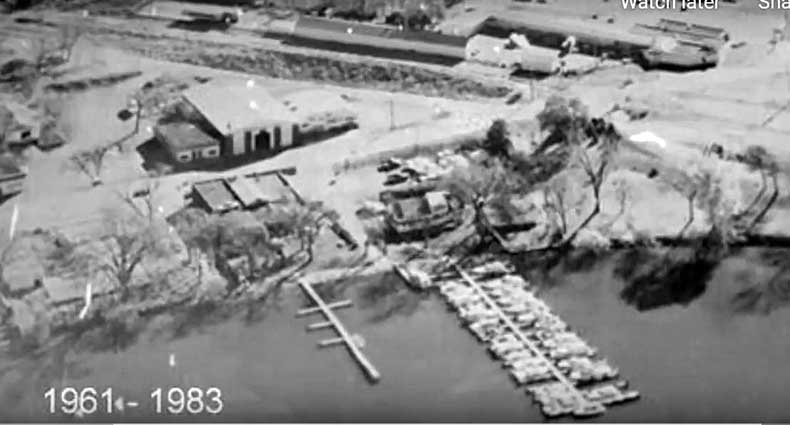
Local artist Stan Straley provides us with a wonderful view of the Downbeat in his painting of the Hollow back in the 1960s, below. Stan explains: “It is a commission I did for the mayor of Spring Park. The Westonka Historical Society had given him a print of Dick Maw’s painting [of the Lakeview – the yellow building] and he wanted me to paint the other side of the street to match it. He made a print of it and gave it to the city to hang in city hall next to the Maw print.” (The Dick Maw print can be seen on the Lakeview page.) The original of the painting below, and prints as well, are available for sale on Stan Straley’s website.
